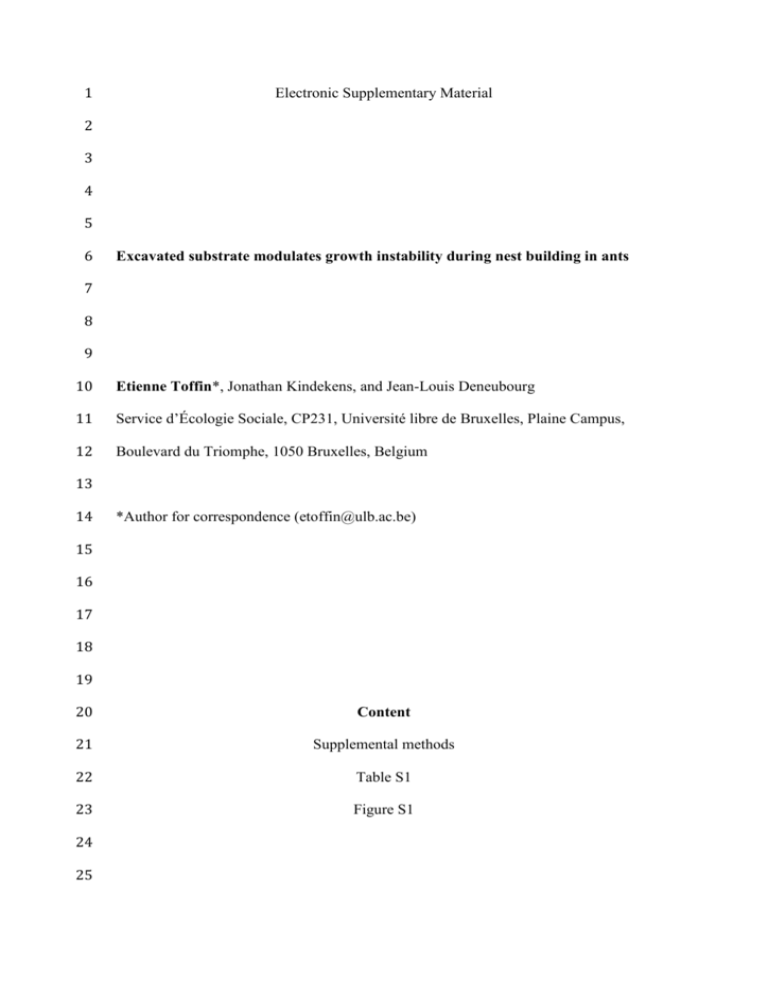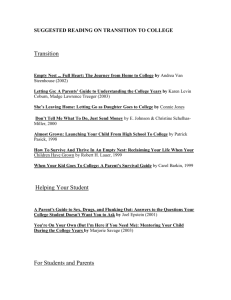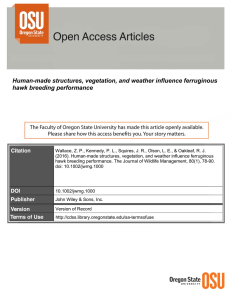Electronic Supplementary Material Excavated substrate modulates
advertisement

1 Electronic Supplementary Material 2 3 4 5 6 Excavated substrate modulates growth instability during nest building in ants 7 8 9 10 Etienne Toffin*, Jonathan Kindekens, and Jean-Louis Deneubourg 11 Service d’Écologie Sociale, CP231, Université libre de Bruxelles, Plaine Campus, 12 Boulevard du Triomphe, 1050 Bruxelles, Belgium 13 14 *Author for correspondence (etoffin@ulb.ac.be) 15 16 17 18 19 20 Content 21 Supplemental methods 22 Table S1 23 Figure S1 24 25 26 (a) Substrate characterization 27 The main protocols that characterize the material properties are made on a 28 macroscopic level as they require several hundred grams of materials to be performed. 29 The mechanical forces tested by these methods (i.e. overall cohesion, resistance to 30 shear stresses, quantitative composition) are not those that govern the ant behaviours 31 (Bonner 2006). On the other hand, measuring the pellet size was inaccurate because 32 of their irregular shape (Cassill et al. 2002). 33 Hence, the mean individual pellet dry weight (table S1) was estimated by 34 counting the number of loaded ants (N) exiting a nest still under excavation and 35 weighing the overall extracted (m) pellets after 1 hour. Each substrate mean density 36 (d) was determined by weighing the material content of a digging setup of known 37 volume five times. The mean number of pellets per cm2 (Npel) and the mean volume of 38 a pellet (V) were thus calculated. 39 40 (b) Simulations 41 All sets of Monte Carlo simulation contained, according to the substrate, the same 42 number of replicates as the experimental groups (Granular: N=24; Cohesive: N=25). 43 Each replicate was defined by two values, its state (initial state is N1) and its area 44 (initial area: A=0). A simulation step corresponded to an increase of 1 mm2 in nest 45 area and can be summarized as below. 46 At each simulation step, A was increased and its state was checked to determine 47 which transition could occur according to the model (figure 3). The probability ki of 48 entering into each of the three alternative states i (2, 3 or Stop) was computed from 49 the following equation 50 ki (A) i i (A c i ) 1 e (S1) 51 Thus, a random number P[0; 1[ was generated and the event that occurred was 52 chosen as: 53 - state Stop if 0≤P<kS, as long as current state≠NS, 54 - state 2 if kS≤P<kS+k2, as long as current state=N1 and state≠NS, 55 - state 3 if kS ≤P<kS+k3, as long as current state=N2 and state≠NS, 56 - if P>kS+k2+k3, the replicate stays in its current state. 57 A simulation ended as soon as a replicate entered the Stop state. 58 Every time a state change occurred, the corresponding value of nest area was 59 stored. The distribution through time (i.e. the increase of nest area) of the replicates 60 according to their state could thus be generated. These results, like the mean area of 61 each state change (morphological transitions or stopping of activity) were used to 62 assess the agreement between experiment and simulation results. 63 64 (c) Determination of 3 and c3 values with simulations 65 The non-linear least square fitting method did not function to fit the survival curves of 66 experiments in state 2 (occurrence of second transition). The values of 3 and c3 were 67 thus determined by means of Monte Carlo simulations. 68 For each couple of parameter values 200 sets of simulations were executed. 69 For each substrate, all the simulated values of A2 and AM were grouped to get a global 70 survival curve of Stage 2. The agreement of simulation and experimental results was 71 assessed by computing the sum of squares between the two survival curves. The 72 resulting landscape indicated that the highest possible value of survival curve non- 73 linearity (3=0.95) and a threshold value equal to that of the first transition (c3=c2) 74 was the best combination to generate results in good agreement with the experimental 75 ones. 76 REFERENCES 77 Bonner, J. T. 2006 Why Size Matters: From Bacteria to Blue Whales. Princeton 78 University Press. 79 Cassill, D. L., Tschinkel, W. R., & Vinson, S. B. 2002 Nest complexity, group size 80 and brood rearing in the fire ant, Solenopsis invicta. Insect Soc 49: 158-163. 81 82 (doi:10.1007/s00040-002-8296-9) 83 84 Table S1 Microscopic characterisation of digging substrates 85 86 87 88 Figure S1 Dynamics of excavation and shape transitions in cohesive substrate 89 (experiment 18). (a) Dynamics of nest excavation, showing evolution of both nest 90 area A (and its fit by equation (3.1), parameters value: α=1.33, β=15.29 h, 91 AM=16.94 cm2) and rate of digging against time. The two morphological transitions 92 are represented by vertical dashed lines. (b) Characterisation of first transition point 93 with the relationship between P and A (ω1=0.40; ω2=1.31; A1=3.80 cm2). (c) 94 Determination of second transition time using scatterplot of A vs AC (γ1=1.82; 95 γ2=7.75; A2=8.31 cm2).









![This article was downloaded by: [South Dakota State University]](http://s2.studylib.net/store/data/010301828_1-decae442ccf8b256fafac3171ecfacfe-300x300.png)
